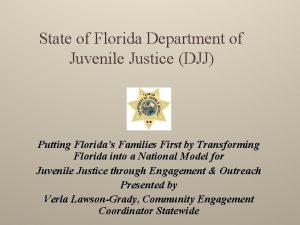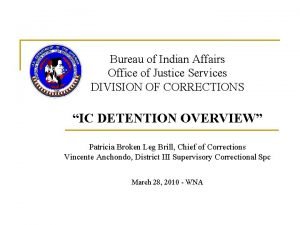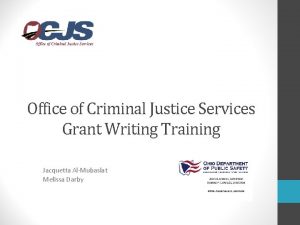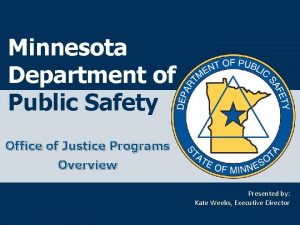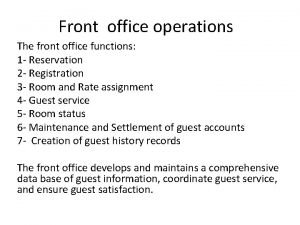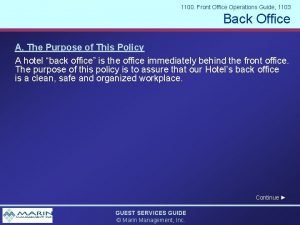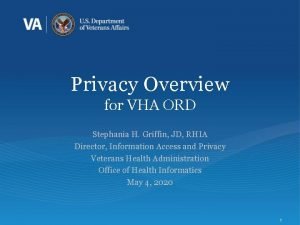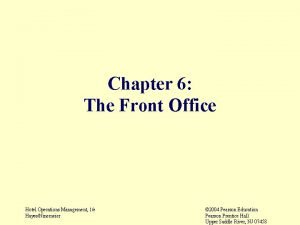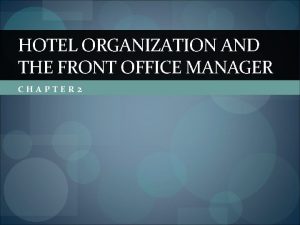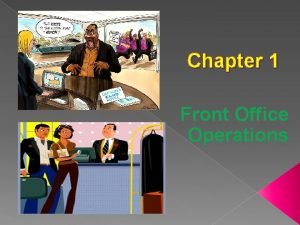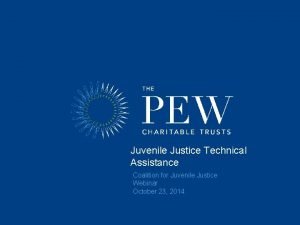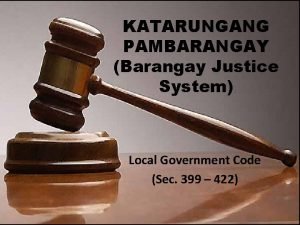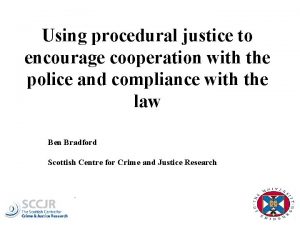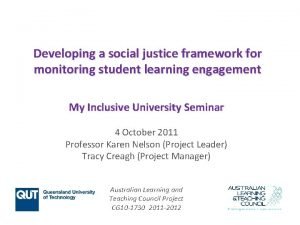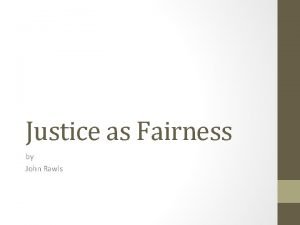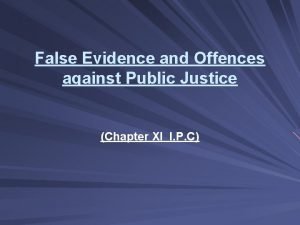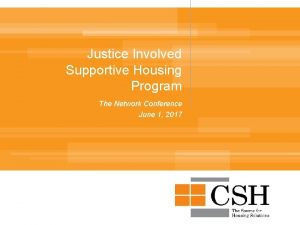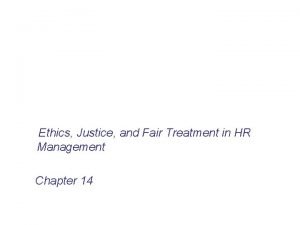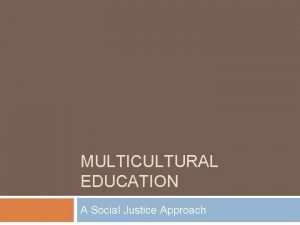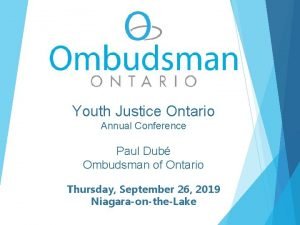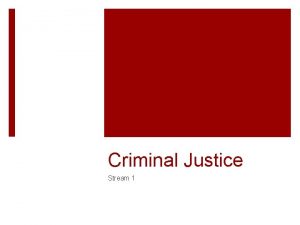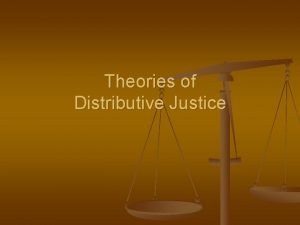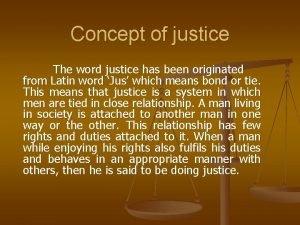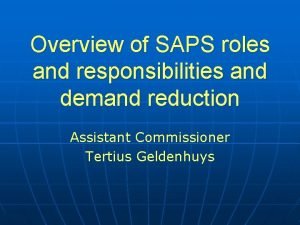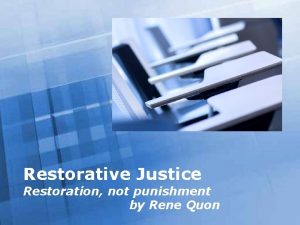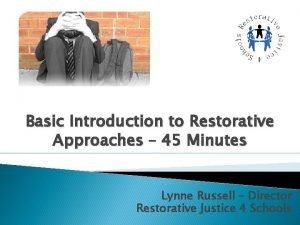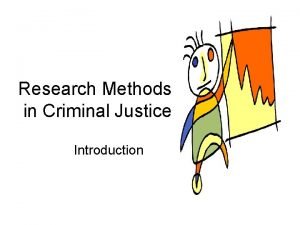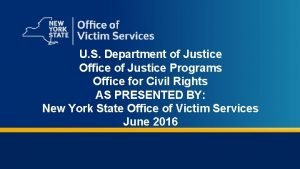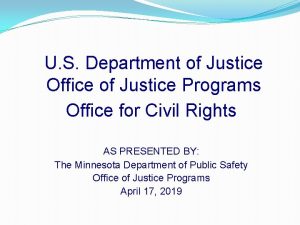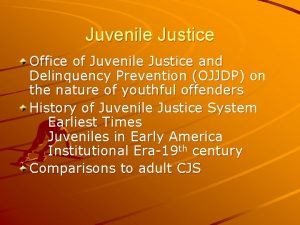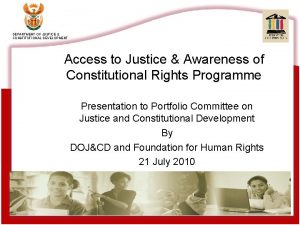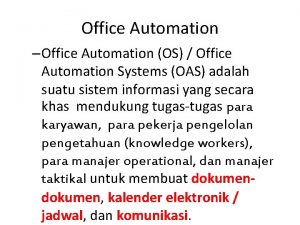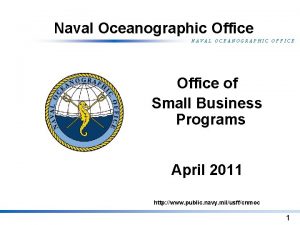U S Department of Justice Office of Justice



















































- Slides: 51

U. S. Department of Justice Office of Justice Programs Office for Civil Rights AS PRESENTED BY: New York State Office of Victim Services June 2016

One Simple Concept… Civil Rights Obligations Whenever Federal funds are involved, there are civil rights requirements that follow

The Office for Civil Rights Enforces: • Title VI of the Civil Rights Act of 1964 • The Omnibus Crime Control & Safe Streets Act of 1968 • Section 504 of the Rehabilitation Act of 1973 • Title II of the Americans with Disabilities Act of 1990 • Age Discrimination Act of 1975 • Title IX of the Education Amendments of 1972 • Section 1407 of the Victims of Crime Act (VOCA)

Title VI, Civil Rights Act of 1964 “No Person in the United States shall, on the ground of race, color, or national origin, be excluded from participation in, be denied the benefits of, or be subjected to discrimination under any program or activity receiving Federal financial assistance. ”

Title VI, Civil Rights Act of 1964 To Whom do the Provisions Apply? Generally, the entire department or office within a state or local government is identified as the “program or activity. ” Example: If a project of a county prosecutor receives Federal funds, the entire prosecutor’s office is covered, but not the other departments in the county.

Title VI, Civil Rights Act of 1964 Title VI Regulations Prohibit: • Providing different services to individuals • Denying the opportunity to participate as a member of planning or advisory body • Selecting the location of a facility with the purpose or effect of excluding individuals

Omnibus Crime Control and Safe Streets Act of 1968 “No person in any state shall, on the ground of race, color, religion, national origin, or sex, be excluded from participation in, be denied the benefits of, or be subjected to discrimination under or be denied employment in connection with any programs or activity funded in whole or in part with funds made available under this chapter. ”

Protected Classes Race Color National Origin Religion Sex Disability Age

Race • American Indian or Alaskan Native • Native Hawaiian or Other Pacific Islander • Black or African American • Asian • White Hispanic / Latino: Is not a race, it is an ethnicity

Color Discrimination Preference for or aversion to persons of different skin colors, regardless of whether the actor is in the same racial or national origin group

National Origin

What is a Religion? All aspects of religious observance, practice, and belief are protected Atheism Christianity Paganism Any Sincerely Held Belief Islam Mormonism Judaism Buddhism

Sex Discrimination Can Occur Between:

Who is in the “Disability” Class? Individuals who have, have a record of having, or are regarded as having a physical or mental impairment which substantially limits one or more major life activities.

What is a Major Life Activity? These are activities that an average person can perform with little or no difficulty, such as: • • Eating Walking Breathing Seeing Hearing Speaking Learning • • Sitting Caring for oneself Working Performing manual tasks Standing Lifting Reading

DISABILITY DEFINITIONS • Mental Impairment: includes any mental or psychological disorder, such as mental retardation, organic brain syndrome, emotional or mental illness, and specific learning disabilities.

Disability Definitions • Physical Impairments: any physiological disorder or condition, cosmetic disfigurement, or anatomical loss affecting one or more of the following systems: • Neurological • Musculoskeletal • Special Sense Organs • Respiratory • Speech Organs • Cardiovascular • Reproductive • Digestive • Genito-Urinary • Hemic • Lymphatic • Skin • Endocrine

Disability Definitions • Substantially Limits: means the individual must be unable to perform, or be significantly limited in the ability to perform, an activity compared to an average person in the general population. Courts have looked at three factors in determining whether someone is substantially limited: 1. 2. 3. Extent: its nature and severity Duration: How long it will last or is expected to last Impact: Its long term impact or expected impact

Disability Definitions • Exclusions: A person who currently uses illegal drugs is not protected by the ADA Homosexuality and bisexuality are not impairments and are therefore not disabilities covered by the ADA

Age Discrimination Act of 1975 • Prohibits Federally funded organizations from discriminating against persons of any age in its programs and activities • Does not cover discrimination in employment • EEOC enforces the Age Discrimination in Employment Act, which prohibits employment discrimination against persons over the age of 40

Employment Discrimination Five Forms of Employment Discrimination: 1. 2. 3. 4. 5. Disparate Treatment Adverse Impact Harassment Failure to Accommodate Retaliation

Disparate Treatment • Consists of intentional discrimination where an employer deliberately takes an adverse action against an employee based on: Race Color National origin Sex Religion Disability

How Do You Prove Intentional Discrimination? • Direct Evidence • Indirect Evidence, such as: Similarly situated people of a different class were treated differently than the complainant Evidence of bias False explanation for the differential treatment Statistical evidence

What is Adverse Impact? Adverse Impact occurs when an employer has a neutral policy or practice which has the effect of excluding employees of a particular race, color, sex, national origin, religion, or disability.

Adverse Impact Examples The following are examples of employment policies which have been found to cause an adverse impact: 1. Minimum height requirements 2. Certain educational requirements 3. Physical agility tests 4. No beard policies

Adverse Impact Evidence of Adverse Impact • The Four-Fifths Rule: When a policy or procedure has a selection rate for any protected class that is less than 4/5 ths (80%) of the rate for the group with the highest rate of selection If a Policy has an Adverse Impact • Choose an alternative with less adverse impact • The policy or practice may still be used if job related and consistent with business necessity

What is Harassment? Harassment is behavior which creates a hostile work environment for individuals because of their race, sex, color, national origin, religion, or disability

What is Harassment?

What Makes a Work Environment Hostile? • A stray remark is not enough to constitute a hostile work environment • The harassment must be sufficiently severe or pervasive to alter the terms and conditions of employment

Determining Severity or Pervasiveness – Six Factors Use a reasonable person standard to determine the following: 1. Was the conduct verbal or physical or both? 2. How frequently was the conduct repeated? 3. Was the conduct hostile or merely offensive 4. Was the harasser a co-worker or supervisor? 5. Did others join in the harassment? 6. Was the harassment directed at more than one individual?

What Can an Employer Do About Unlawful Harassment? • • Take Preventative Action Develop an explicit policy regarding harassment Regularly train all employees Develop effective sanctions Develop a complaint procedure designed to: Protect victims and witnesses Encourage complaints Ensure confidentiality against retaliation

What Can an Employer Do About Unlawful Harassment? Take Remedial Action • Promptly and thoroughly investigate all complaints of harassment • Take immediate action and appropriate corrective action reflecting the severity of the conduct • Restore lost employment benefits or opportunities • Discipline the offending employee or supervisor • Follow up with the victim to ensure there has been no retaliation

Accommodation: Religion & Disability • An employer must make a reasonable accommodation to the known physical or mental limitations of a qualified applicant or employee with a disability • An employer must make a reasonable accommodation to the known religious beliefs or practices of an applicant or employee

Protection for Employees • Retaliation against an employee for opposing an unlawful employment practice or participating in an investigation, proceeding, or hearing under the following statutes is prohibited: Title VI of the Civil Rights Act The Americans With Disabilities Act The Omnibus Crime Control and Safe Streets Act Title IX of the Education Amendments The Rehabilitation Act The Age Discrimination Act

Protection for Employees • As long as an employee had a reasonable and good faith belief that the employer’s conduct was illegal, even if the employee turns out to be wrong, the employee is protected • However, if the way the individual chooses to protest perceived discrimination is unreasonable or if the opposition is false and malicious, the antiretaliation provisions will not apply

Discrimination in Delivery of Services Whenever a service is provided, there are potential beneficiaries, and those beneficiaries must be treated equally regardless of race, sex, national origin, age, color, disability, or religion • Think of a program in which you are involved that receives federal funding: Who are the potential beneficiaries? What are the potential civil rights issues?

Civil Rights Laws & American Indians: An Important Distinction Recipient When Tribes receive Federal financial assistance, they are not subject to the enforcement of Federal Civil Rights Laws when they function as an employer; tribes may be responsible as a provider of services. Beneficiary American Indians, as employees or as beneficiaries of a non-Tribal organization receiving Federal financial assistance are protected by Federal Civil Rights Laws.

Civil Rights Laws & American Indians The following protected classes are of particular importance for American Indians and Alaska Natives: Race National Religion Origin

Civil Rights Laws & American Indians • Definition of American Indian for Civil Rights protections: An employee would be entitled to protection of Title VII against employment discrimination regardless of his percentage of Native American ancestry if the employer reasonably believed that the employee was a member of a protected class based on some objective evidence, which may consist of physical appearance, language, cultural activities, or associations. One does not have to prove bloodlines or show tribal membership to be eligible for protection under Federal Civil Rights Laws.

Civil Rights Laws & American Indians • Discrimination in employment on the basis of membership in a particular Indian tribe (e. g. favoring members of the Navajo Tribe over members of the Hopi Tribe) constitutes national origin discrimination in violation of Title VII

States & American Indians • A State may be discriminating against American Indians if the State has implemented a policy of denying funding to Tribes, based on Tribes having received or having direct access to Federal Financial Assistance • The Safe Streets Act contains a State liability waiver in regard to Indian Tribes • States do not need to require Indian Tribes to waive sovereign immunity to qualify as subgrantees

Limited English Proficiency • A Limited English Proficient (LEP) person has a first language other than English and a limited ability to read, speak, or understand English. • National Origin Discrimination includes discrimination on the basis of LEP • Recipients of Federal financial assistance have an obligation to reduce language barriers that can preclude meaningful access by LEP persons to important benefits, rights, programs, information and services.

Limited English Proficiency To avoid discrimination against LEP persons, recipients must do the following: Take reasonable steps to ensure meaningful access to the programs, services, and information the recipients provide, free of charge. Establish and implement policies and procedures for language assistance services that provide LEP persons with meaningful access.

Limited English Proficiency Determining Reasonable Steps: Four Factor Analysis – 1. 2. 3. 4. The number or proportion of LEP persons served or encountered in the eligible service population The frequency with which LEP individuals come in contact with the program The nature and importance of the program, activity, or services provided by the program The resources available to the recipient

Limited English Proficiency Language Services Oral Language Services Translation • Bilingual Staff: Direct foreign language communication by fluent personnel • Interpreters: Ensure interpreter competency. Usually family members, friends, and uncertified co-workers are not appropriate Safe Harbor Provision: • Applies only to translation of written materials • Based on number of LEP persons served

Limited English Proficiency Five Elements of a written LEP Policy: 1. A process for identifying LEP persons who need language assistance 2. Identifying ways in which language assistance will be provided 3. Training for staff 4. Monitoring and updating the LEP policy 5. Providing notice to LEP persons

Assurances The Applicant assures and certifies that: � (11)It will comply, and assure the compliance of all its subgrantees and contractors… � (13)It will comply, and its contractors will comply, with the Nondiscrimination Requirements of the Omnibus Crime Control and Safe Streets Act of 1968 [and other Federal civil rights statutes and regulations]. � (14)In the event a Federal or State court or Federal or State administrative agency makes a Finding of Discrimination after a due process hearing on the ground of race, color, religion, national origin, sex or disability against a recipient of funds, the recipient will forward a copy of the finding to the Office for Civil Rights, Office of Justice Programs � (15)It will provide an Equal Employment Opportunity Program if required to maintain one, where the application is for $500, 000 or more

The Office of Justice Programs & Civil Rights Enforcement OJP is responsible for the following areas of Civil Rights Enforcement: Complaints Compliance Reviews Findings of Discrimination EEOPs (Equal Employment Opportunity Plans)

The Complaint Process

Findings of Discrimination

Questions? Contact: Emma Graham, Supervisor of Contract Administration NYS Office of Victim Services A. E. Smith State Office Building 80 South Swan Street, 2 nd Floor Albany, NY 12210 518. 485. 2763 www. ovs. ny. gov
 State of florida department of juvenile justice
State of florida department of juvenile justice New york state division of criminal justice services
New york state division of criminal justice services Us department of justice
Us department of justice Office of justice services
Office of justice services Ocjs grants
Ocjs grants Office of justice programs mn
Office of justice programs mn Front office assignment
Front office assignment Back office department in hotel
Back office department in hotel Front office department responsibilities
Front office department responsibilities Va form 10-250
Va form 10-250 Front office operations and management
Front office operations and management Front office organizational chart of a small hotel
Front office organizational chart of a small hotel Reservation rack in front office
Reservation rack in front office Difference between office location and office layout
Difference between office location and office layout Ecojustice saskatoon
Ecojustice saskatoon Liberty and justice for all
Liberty and justice for all Coalition for juvenile justice
Coalition for juvenile justice Katarungang pambarangay local government code
Katarungang pambarangay local government code Procedure justice
Procedure justice Eastbourne coroners office
Eastbourne coroners office Consensus model criminal justice
Consensus model criminal justice Principle of social justice
Principle of social justice Lawyer chandru caste
Lawyer chandru caste Veil of ignorance example
Veil of ignorance example False evidence and offences against public justice
False evidence and offences against public justice Justice involved supportive housing
Justice involved supportive housing Ethics justice and fair treatment in hrm
Ethics justice and fair treatment in hrm Juvenile justice system in georgia
Juvenile justice system in georgia Procedural law
Procedural law Who is lapu lapu in pnp
Who is lapu lapu in pnp Honesty and justice
Honesty and justice Persuasive techniques definition
Persuasive techniques definition Pantoum of the great depression
Pantoum of the great depression Social justice approach
Social justice approach Solidarity definiton
Solidarity definiton Youth justice ontario
Youth justice ontario Barbara kruger justice
Barbara kruger justice The tempest themes
The tempest themes Justice definiton
Justice definiton Mercy bears richer fruits than strict justice
Mercy bears richer fruits than strict justice 4 pillars of justice
4 pillars of justice Theories of distributive justice
Theories of distributive justice Justice jennifer davies
Justice jennifer davies Justice picture meaning
Justice picture meaning Responsibilities and functions of saps
Responsibilities and functions of saps Restorative justice in schools powerpoint
Restorative justice in schools powerpoint Restorative justice script
Restorative justice script Inaccurate observation in criminal justice
Inaccurate observation in criminal justice Compensatory justice examples
Compensatory justice examples Shantha ready alonso
Shantha ready alonso Disruptive justice
Disruptive justice Establish justice definition
Establish justice definition
